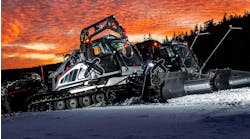Slacking off on slack adjuster maintenance a costly proposition
This is Part Two of a two-part story. To read Part One, click here.
Even seemingly minor issues in the brake system can have a big impact on uptime. During 2023’s International Roadcheck, an annual safety and enforcement initiative held by the Commercial Vehicle Safety Alliance (CVSA), more than 4,400 OOS violations were issued due to brakes in North America. It was the top vehicle system offender during the inspection period, with 25% of OOS violations.
This year CVSA announced that brakes will be under even more scrutiny, with missing camshaft bushings added to the 20% criteria for drum and air brakes, increasing the likelihood of a brake OOS violation. Undermaintained automatic slack adjusters were one of the potential OOS indicators that Bendix Commercial Vehicle Systems warned against. “You can spot adjustment issues if you notice slack adjusters that are extended at different angles on the same axle,” said Mark Holley, Bendix director of marketing and customer solutions, Wheel-End.
In the U.S., out-of-adjustment brakes and defective automatic slack adjusters were the two most common brake violations, with 5,727 violations and 3,475 violations, respectively. “If you have two brakes out of adjustment on a tractor-trailer total, they won’t let you go,” said Kevin Pfost, product specialist at Bendix. “Your truck is now out of service.”
Read more: How to equip fleets and technicians for transmission troubles
No one wants that, nor do they want trucks with anything other than perfectly operating brake systems, which means that technicians need to understand one brake system component in particular: the automatic slack adjuster.
Purpose of slack adjusters
Slack adjusters actuate a vehicle’s brakes by turning the lateral movement of the pushrod from the air chamber into torque that turns the camshaft, which in turn pushes the brake shoes outward against the brake drum to slow the truck. As brake shoes wear out, slack adjusters also compensate for the wear by adjusting the brake stroke, or distance between the shoe and the drum, to stay within regulation.
Older vehicles might still have manual slack adjusters, which perform the same function but require manual adjustment for optimal brake performance. However, they’re less common now. Most modern trucks with air brakes are equipped with ASAs, as they reduce the need for manual adjustments by maintaining the distance between the brake drum and lining, said Gerry Mead, maintenance consultant and former fleet executive.
Drivers can experience uneven braking if a slack adjuster isn’t adjusting enough, whether manual or automatic. But overadjusted ASAs leads to dragging brakes, which Bendix noted can lead to a 1.5% increase in fuel consumption.
Fleets with dragging brakes “have premature wear” and “they’re using up fuel,” Mead noted. “They’re just not getting the life out of their brake system.”
And, of course, there’s always the DOT to consider.
“If the adjuster is not operating properly, it may not be self-adjusting, so now your brake will be out of adjustment, and that’s when the DOT will give you a ticket,” Pfost noted. And these tickets can range from $500-$1,848 per count, plus a $500 administration fee.




